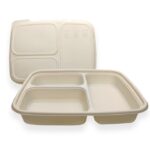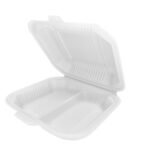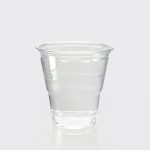RPET Food Containers are transforming the foodservice and retail industries by providing eco-friendly, durable, and food-grade solutions. From disposable plastic cups with lids to transparent plastic boxes, including fruit, salad, and bread containers, RPET Food Containers combine clarity, safety, and recyclability. Businesses can now meet sustainability goals while delivering premium product presentation and convenience.
01 The Rise of RPET Food Containers
In the past decade, sustainability and environmental awareness have driven a shift in food packaging. Traditional PET has long been favored for its strength and clarity, but RPET Food Containers take this a step further by using recycled materials without sacrificing quality. This helps reduce plastic waste, lowers carbon footprint, and supports circular economy initiatives.
Consumers today care about transparency—not just in packaging, but also in environmental responsibility. Transparent plastic boxes made of RPET Food Containers allow products to be showcased clearly. Fresh cherry tomatoes, ripe strawberries, and vibrant salads are visible to consumers, enhancing trust and appeal while aligning with sustainable values.
The adoption of RPET Food Containers also aligns with stricter food safety standards. Made from food-grade RPET, these containers ensure no harmful substances leach into food while maintaining structural durability and aesthetic appeal.
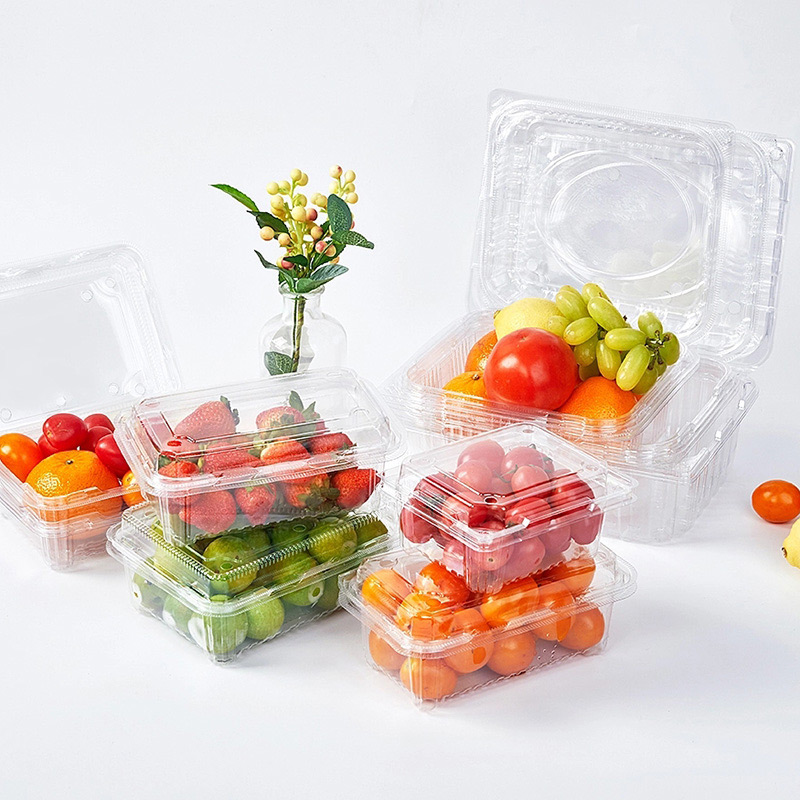
02 Product Overview: RPET Food Containers
RPET Food Containers for Beverages
RPET Food Containers include disposable plastic cups with lids designed for coffee, tea, and other beverages. Key features:
-
Material: Food-grade RPET
-
Transparency: Crystal clear for beverage visibility
-
Durability: Handles hot and cold liquids without deformation
-
Eco Advantage: Fully recyclable, supporting circular PET streams
These cups are ideal for coffee shops, cafes, and beverage chains seeking premium, sustainable packaging solutions.
Transparent Plastic Boxes
-
Fruit Boxes – Perfect for cherry tomatoes, strawberries, and mixed fruits. Clear lids maintain freshness and enhance product display in retail environments.
-
Salad Containers – Available in single or multiple compartments, keeping ingredients separate to preserve taste and freshness. Ideal for meal prep and takeout services.
-
Bread Boxes – Designed for baked goods, offering strength and transparency to prevent damage while showcasing contents.
All containers meet food-grade standards, ensuring direct food contact safety.
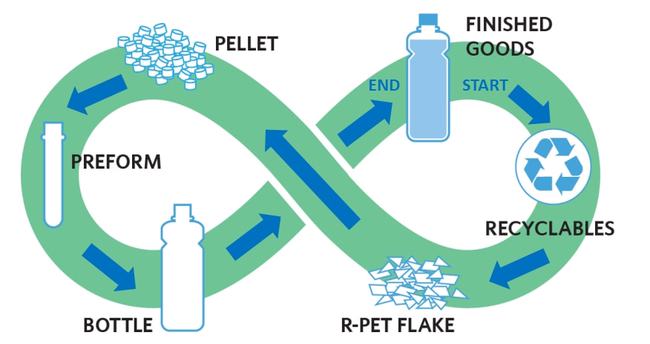
03 Applications of RPET Food Containers
Retail & Supermarkets
RPET Food Containers enhance shelf appeal with their transparency, allowing customers to instantly see the product quality. Transparent plastic boxes improve merchandising for fresh produce, salads, and bakery items. Their combination of safety, clarity, and eco-friendliness positions RPET Food Containers as a preferred choice in modern retail.
Foodservice & Takeout
Disposable plastic cups with lids are essential for coffee shops, juice bars, and quick-service restaurants. They offer convenience while reducing single-use plastic waste. RPET Food Containers for salads and meals keep food fresh and safe for consumers on the go.
E-commerce & Meal Kits
RPET Food Containers are ideal for meal kit delivery due to their lightweight, durable, and recyclable nature. Transparent packaging maintains product integrity during transit, while environmentally conscious consumers appreciate the sustainable choice.
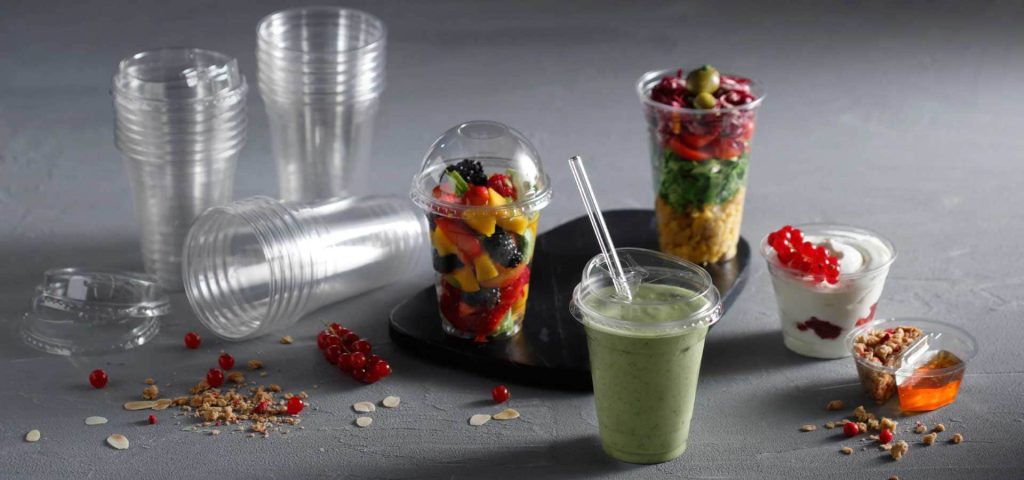
04 Benefits of RPET Food Containers
-
Sustainability – Made from recycled PET, reducing virgin plastic usage and supporting circular economy practices.
-
Food Safety – Certified food-grade material ensures safety for direct food contact.
-
Transparency – Crystal-clear containers allow consumers to see product quality, improving trust and marketing impact.
-
Durability – Resistant to cracking or deformation, suitable for both hot and cold items.
-
Cost Efficiency – Competitively priced compared to PLA or other compostable alternatives.
-
Customizability – Branding, printing, and labeling options enhance marketing and product visibility.
05 Challenges in Adopting RPET Food Containers
Despite advantages, adoption challenges remain:
-
Perceived Costs: Initial investment may seem higher than traditional plastics, though lifecycle and sustainability benefits often justify the price.
-
Recycling Infrastructure: RPET recycling facilities are not universally available, potentially limiting material recovery.
-
Market Education: Businesses and consumers must understand the benefits and recyclability of RPET Food Containers, which requires awareness campaigns.
Successful adopters report improved brand perception, stronger consumer trust, and alignment with corporate sustainability goals.
06 Frequently Asked Questions
Q1: Can RPET Food Containers be microwaved?
A1: Most RPET Food Containers are suitable for cold or room-temperature foods. Certain heat-resistant versions support limited microwave use; always check specifications.
Q2: Are RPET Food Containers safe for hot beverages?
A2: Yes, disposable plastic cups with lids made from RPET can handle hot drinks up to typical temperatures (around 70–80°C).
Q3: How do I recycle RPET Food Containers?
A3: Collect in standard PET recycling streams, ensuring containers are clean and free of food residue.
Q4: Can RPET Food Containers be customized?
A4: Yes, printing, labeling, and size customization are available to match branding and product display needs.
Q5: What products are best suited for RPET Food Containers?
A5: Fresh fruits like cherry tomatoes and strawberries, salads, baked goods, beverages, and ready-to-eat meals benefit most from RPET Food Containers.
07 Future Outlook: RPET Food Containers
The demand for sustainable packaging is rising globally. RPET Food Containers represent a major trend, combining durability, transparency, and recyclability. Businesses adopting RPET can:
-
Reduce environmental impact and plastic waste
-
Strengthen brand image as eco-conscious
-
Comply with global sustainability regulations
-
Offer attractive, functional, and durable packaging solutions
RPET Food Containers are more than just material alternatives—they are strategic enablers for sustainable and responsible business practices.
Conclusion
From disposable plastic cups with lids to transparent plastic boxes for fruits, salads, and bread, RPET Food Containers are redefining food packaging. Combining transparency, durability, food-grade safety, and recyclability, RPET helps businesses meet sustainability goals while delivering premium consumer experiences.
The future of food packaging is clear: transparency, eco-friendliness, and quality can coexist. RPET Food Containers allow companies to embrace this future, protecting the planet while enhancing brand value.
References
-
PET and RPET Packaging Overview – https://www.bpf.co.uk
-
Sustainability Benefits of RPET – https://www.plasticrecycling.org
-
Food-Grade Plastic Regulations – https://www.fda.gov/food
-
Eco-Friendly Packaging Trends – https://www.packagingdigest.com
-
Recycled PET in the Circular Economy – https://www.recycledpet.org
-
Global Food Packaging Insights – https://www.packagingeurope.com

